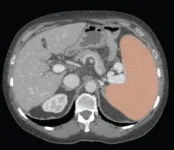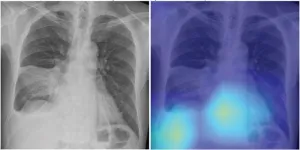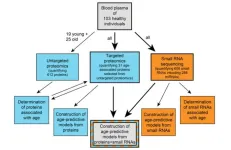(Press-News.org) COVID-19 vaccination helped reduce disparities in disease incidence between low- and high-income communities, according to a new analysis led by Cedars-Sinai investigators.
While lower-income communities had lower vaccination rates than higher-income communities, the impact of vaccination on disease incidence was larger in lower-income communities. As a result, investigators say, vaccination led to reduced income-related disparities in COVID-19 incidence.
The findings were published today in the Morbidity and Mortality Weekly Report, a publication of the Centers for Disease Control and Prevention (CDC).
“This study is a unique demonstration of how vaccination promotes health equity,” said Timothy Daskivich, MD, assistant professor of Surgery at Cedars-Sinai and senior author of the study. “Through this investigation, we also found that disparities in COVID-19 incidence between low- and high-income communities in the first two surges in Los Angeles were not observed in the first surge that occurred after vaccines were widely distributed.”
The findings also serve as a model for future pandemics and mass vaccination needs across the country, said Daskivich.
“This study shows the benefit of prioritizing vaccine efforts in underserved communities to reduce disparities and improve overall population health,” Daskivich said.
The analysis included vaccination and reported COVID-19 illness data from 81 Los Angeles communities, representing more than 5 million people.
Community-level COVID-19 vaccination coverage and incidence data from April 2020 through September 2021 was obtained from the Los Angeles Times COVID-19 data repository, which is populated with California Department of Public Health data.
Key findings from the Cedars-Sinai analysis include:
In 81 assessed Los Angeles communities, COVID-19 incidence during two surges before the availability of vaccines—July 2020 and January 2021—was higher in lower-income communities relative to higher-income communities.
During the first surge after vaccines became available—September 2021—the disparity in COVID-19 incidence between the highest- and lowest-income communities disappeared.
The impact of vaccination on COVID-19 incidence was highest in the lowest-income communities despite lower vaccination coverage.
Study authors point to public health programs that helped reduce disease incidence disparities. For instance, efforts in California included allocating 40% of vaccination appointments to communities in the lowest quartile of the California Healthy Places Index early in the vaccine rollout.
“Our study, alongside California’s initiative to target vaccine rollouts, highlight the importance of improving vaccination access and reducing vaccine hesitancy in underserved communities to reduce disparities in COVID-19 incidence,” said Brennan Spiegel, MD, MSHS, director of Health Services Research at Cedars-Sinai and an author of the study. “Reducing barriers to vaccination in lower-income communities, including providing updated COVID-19 vaccine boosters, is critical to reducing disparities in disease burden and decreasing COVID-19–related illness in the United States.”
Other Cedars-Sinai authors involved in the study include John Masterson, MD, and Michael Luu, MPH.
END
COVID-19 vaccination reduced disease disparities between low- and high-income communities
Cedars-Sinai investigators measured the impact of vaccination in Los Angeles county
2023-07-01
ELSE PRESS RELEASES FROM THIS DATE:
Immune-boosting therapy helps honey bees resist deadly viruses
2023-07-01
Scientists have successfully tested a novel way of boosting honey bees’ immune systems to help them fend off deadly viruses, which have contributed to the major losses of the critical pollinator globally.
In a new study, the research team, which includes entomologists with the University of Florida, the Agricultural Research Service-USDA, Louisiana State University and the University of Nebraska-Lincoln, showed that prompting honey bees’ cells to produce free radicals helped the bees weather a host of viruses. In fact, the treatment greatly reduced, and in some cases, nearly eliminated virus ...
Biomedical Sciences researcher gets $2.67 million grant to study cardiac disease in diabetes
2023-07-01
ATLANTA — Dr. Jun Zou, a research assistant professor in the Institute for Biomedical Sciences at Georgia State University, has received a five-year, $2.67 million federal grant to study the link between gut dysbiosis, an imbalance in the microbiota, and cardiac disease in diabetes.
The grant from the National Institutes of Health’s National Heart, Lung, and Blood Institute will be used to explore the role of diabetes-induced alteration of gut microbiota ...
US Department of Energy releases plan to ensure free, immediate, and equitable access to federally funded research
2023-06-30
WASHINGTON, D.C. — The U.S. Department of Energy (DOE) today released a plan to ensure the Department’s Federally funded research is more open and accessible to the public, researchers, and journalists as part of a broader effort by the Biden-Harris Administration to make government data more transparent. With 17 National Laboratories and scores of programs that fund university and private research, DOE directly supports thousands of research papers per year, and, when this plan goes into effect, those findings will be available ...
AI with volumetric thresholds facilitate opportunistic screening for splenomegaly
2023-06-30
Leesburg, VA, June 30, 2023—According to an accepted manuscript published in ARRS’ own American Journal of Roentgenology (AJR), using an automated deep-learning AI tool, as well as weight-based volumetric thresholds, might afford large-scale evaluation for splenomegaly on CT examinations performed for any indication.
Noting that, historically, the standard linear splenic measurements used as a surrogate for splenic volume yielded suboptimal performance in detecting volume-based splenomegaly, “the ...
Deep-learning chest radiograph model predicts mortality for community-acquired pneumonia
2023-06-30
Leesburg, VA, June 30, 2023—According to an accepted manuscript published in ARRS’ own American Journal of Roentgenology (AJR), a deep learning-based model using initial chest radiographs predicted 30-day mortality in patients with community-acquired pneumonia (CAP), improving upon the performance of an established risk prediction tool (i.e., CURB-65 score).
“The deep learning (DL) model may guide clinical decision-making in the management of patients with CAP by identifying high-risk patients who warrant hospitalization and intensive treatment,” concluded first author Eui Jin Hwang, MD, PhD, from the department of radiology at Seoul National ...
Astrophysicists propose a new way of measuring cosmic expansion: lensed gravitational waves
2023-06-30
(Santa Barbara, Calif.) — The universe is expanding; we’ve had evidence of that for about a century. But just how quickly celestial objects are receding from each other is still up for debate.
It’s no small feat to measure the rate at which objects move away from each other across vast distances. Since the discovery of cosmic expansion, its rate has been measured and re-measured with increasing precision, with some of the latest values ranging from 67.4 up to 76.5 kilometers per second per megaparsec, which relates the recession velocity (in ...
Age prediction from human blood plasma using proteomic and small RNA data: A comparative analysis
2023-06-30
“[...] we see our work as an indication that combining different molecular data types could be a general strategy to improve future aging clocks.”
BUFFALO, NY- June 30, 2023 – A new research paper was published on the cover of Aging (listed by MEDLINE/PubMed as "Aging (Albany NY)" and "Aging-US" by Web of Science) Volume 15, Issue 12, entitled, “Age prediction from human blood plasma using proteomic and small RNA data: a comparative analysis.”
Aging clocks, built from comprehensive molecular data, have emerged as promising tools ...
New A.I. system can decode fruit fly behaviors. Why that’s ‘pivotal’ for future human genetics research
2023-06-30
How can you tell if a fruit fly is hungry? Ask a computer.
While that may sound like a bad dad joke, it’s reality at Tulane University, where researchers have developed a new A.I. tool that can tell you if a fruit fly is hungry, sleepy or singing (yes, fruit flies sing).
Dubbed MAFDA (for Novel Machine-learning-based Automatic Fly-behavioral Detection and Annotation) the system uses cameras and a newly developed software to track and identify complex interactive behaviors of individual flies within a larger group. This allows researchers to compare and contrast the behaviors of fruit flies with different genetic backgrounds.
For more than a century, ...
Breast cancer by age: Study reveals early mutations that predict patient outcomes
2023-06-30
LA JOLLA, CALIF. – June 30, 2023 – A study led by researchers at Sanford Burnham Prebys has found that in young women, certain genetic mutations are associated with treatment-resistant breast cancer. These mutations are not linked to treatment-resistant breast cancer in older women. The findings, published in the journal Science Advances, could help improve precision medicine and suggest a brand-new way of classifying breast cancer.
“It’s well established that as you get older, you’re more likely to develop cancer. But we’re finding that this may not be true for all cancers depending on a person’s genetic makeup,” ...
Displays controlled by flexible fins and liquid droplets more versatile, efficient than LED screens
2023-06-30
CHAMPAIGN, Ill. — Flexible displays that can change color, convey information and even send veiled messages via infrared radiation are now possible, thanks to new research from the University of Illinois Urbana-Champaign. Engineers inspired by the morphing skins of animals like chameleons and octopuses have developed capillary-controlled robotic flapping fins to create switchable optical and infrared light multipixel displays that are 1,000 times more energy efficient than light-emitting devices.
The new study led by mechanical science and engineering professor Sameh Tawfick demonstrates ...
LAST 30 PRESS RELEASES:
Bluey’s dad offered professorial chair in archaeology at Griffith University
Beyond small data limitations: Transfer learning-enabled framework for predicting mechanical properties of aluminum matrix composites
Unveiling non-thermal catalytic origin of direct current-promoted catalysis for energy-efficient transformation of greenhouse gases to valuable chemicals
Chronic breathlessness emerging as a hidden strain on hospitals
Paleontologists find first fossil bee nests made inside fossil bones
These fossils were the perfect home for ancient baby bees
Not everyone reads the room the same. A new study examines why.
New research identifies linked energy, immune and vascular changes in ME/CFS
Concurrent frailty + depression likely boost dementia risk in older people
Living in substandard housing linked to kids’ missed schooling and poor grades
Little awareness of medical + psychological complexities of steroid cream withdrawal
Eight in 10 trusts caring for emergency department patients in corridors, finds BMJ investigation
NASA’s Webb telescope finds bizarre atmosphere on a lemon-shaped exoplanet
The gut bacteria that put the brakes on weight gain in mice
Exploring how patients feel about AI transcription
Category ‘6’ tropical cyclone hot spots are growing
Video: Drivers struggle to multitask when using dashboard touch screens, study finds
SLU research shows surge in alcohol-related liver disease driving ‘deaths of despair’
Rising heat reshapes how microbes break down microplastics, new review finds
Roots reveal a hidden carbon pathway in maize plants
Membrane magic: FAMU-FSU researchers repurpose fuel cells membranes for new applications
UN Member States pledge to increase access to diagnosis and inhaled medicines for the 480 million people living with COPD
Combination therapy shows potential to treat pediatric brain cancer ATRT
Study links seabird nesting to shark turf wars in Hawai‘i
Legal sports betting linked to sharp increases in violent crime, study finds
Breakthrough AI from NYUAD speeds up discovery of life-supporting microbes
New Eva Mayr-Stihl Foundation funding initiative boosts research at University of Freiburg on adaptation of forests to global change
The perfect plastic? Plant-based, fully saltwater degradable, zero microplastics
Bias in data may be blocking AI’s potential to combat antibiotic resistance
Article-level metrics would provide more recognition to most researchers than journal-level metrics
[Press-News.org] COVID-19 vaccination reduced disease disparities between low- and high-income communitiesCedars-Sinai investigators measured the impact of vaccination in Los Angeles county







